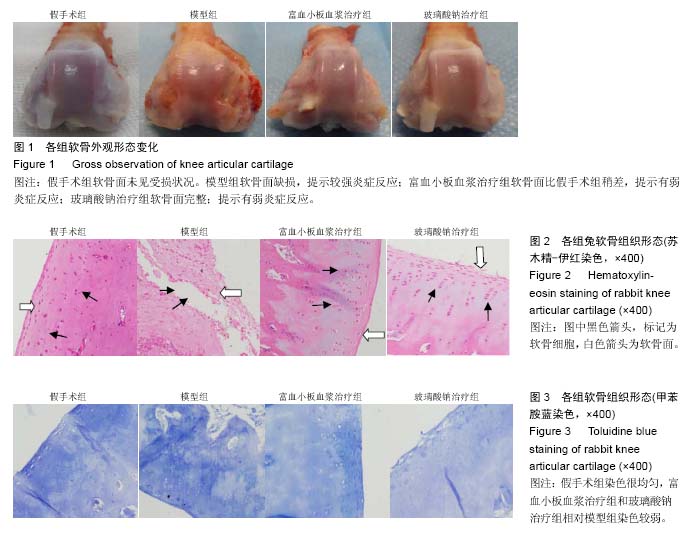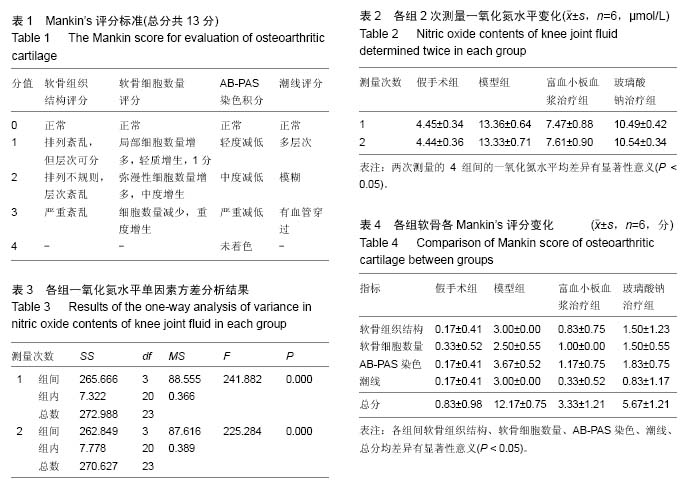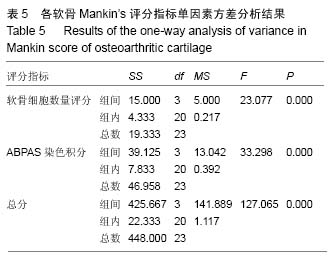| [1] Loeser RF. Aged-related changes in the musculoskeletal system and the development of osteoarthritis. Clin Geriatr Med. 2010;26(3):371-386.
[2] 包德明.膝关节骨关节炎的治疗进展[J].中医正骨,2014, 26(12):52-55.
[3] Bhatia A, Peng P, Cohen SP. Radiofrequency procedures to relieve chronic knee pain: an evidence-based narrative review. Reg Anesth Pain Med. 2016.
[4] McCrum C. Therapeutic review of methylprednisolone acetate intra-articular injection in the management of osteoarthritisof the knee-part 2: clinical and procedural considerations. Musculoskeletal. 2016.
[5] Kazakos K, Lyras DN, Verettas D, et al. The use of autologous PRP gel as an aid in the management of acute trauma wounds. Injury. 2009;40(8):801-805.
[6] 王鹏飞.兔血小板血浆制备及其活性分析[J].中国组织工程研究,2013,17(8):1411-1417.
[7] Sampson S, Reed M, Silvers H, et al. Injection of platelet-rich plasma in patients with primary and secondary knee osteoarthritis: a plot study. Am J Phys Med Rehabil. 2010;89(12):961-969.
[8] 贾俊杰,宋锦旗,黄磊,等.富血小板血浆联合主动运动对大鼠髌股关节全层软骨缺损的修复效果研究[J].中华创伤骨科杂志,2014,16(6):512-517.
[9] Landesberg R, Roy M, Glickman RS. Quantification of growth factor levels using a simplified method of platelet-rich plasma gel preparation. J Oral Maxillofac Surg. 2000;58(3):297-300.
[10] Sabarish R, Lavu V, Rao SR. A Comparison of Platelet Count and Enrichment Percentages in the Platelet Rich Plasma (PRP) Obtained Following Preparation by Three Different Methods. J Clin Diagn Res. 2015;9(2): zc10-zc12.
[11] Fang J, Yin Z, Wang W, Lu M, et al, Effects of leucocyte- and platelet-rich plasma on osteogenic differentiation of bone marrow mesenchymal stem cells in treating avascular necrosis of femoral head in rabbits. Zhongguo Guo Xiu Fu Chong Jian Wai Ke Za Zhi. 2015;29(2):227-233.
[12] 张莹,高银,黄锦,等.氯胺酮分别联合异丙嗪、戊巴比妥钠和水合氯醛药物用于兔麻醉效果的比较与评价[J].医学研究生学报,2013,12(26):1241-1243.
[13] Rogart JN, Barrach HJ, Chichester CO. Articular collagen degradation in the hulth-Telhag model of osteoarthritis. Osteoarthritis Cartilage. 1999;7(6): 539-547.
[14] Zhang C, Huang Y, Zhang QZ, et al. Effect of Bushen Gujin Recipe on serum and synovia interleukin-1 and tumor necrosis factor-alpha of knee osteoarthritis model rabbits. Zhongguo Zhong Xi Yi Jie He Za Zhi. 2015;35(3):355-358.
[15] Xu SY, Zhang LM, Yao XM, et al. Effects and mechanism of low-intensity pulsed ultrasound on extracellular matrix in rabbit knee osteoarthritis. Zhongguo Gu Shang. 2014;27(9):766-771.
[16] 石岩,梅世昌.医学动物实验实用手册[M].北京:中国农业出版社,2002,12:18.
[17] Iannitti T, Elhensheri M, Bingol AO, et al. Preliminary histopathological study of intra-articular injection of a novel highly cross-linked hyaluronic acid in a rabbit model of knee osteoarthritis. J Mol Histol. 2013;44(2): 191-201.
[18] Lu W, Wang L, Wo C, et al. Ketamine attenuates osteoarthritis of the knee via modulation of inflammatory responses in a rabbit model. Mol Med Rep. 2016;13(6):5013-5020.
[19] Liang CX, Guo Y, Tao L, et al. Effects of acupotomy intervention on regional pathological changes and expression of carti- lage-mechanics related proteins in rabbits with knee osteoarthritis. Zhen Ci Yan Jiu. 2015; 40(2):119-124.
[20] Wang CC, Yang KC, Lin KH, et al. Expandable scaffold improves integration of tissue-engineered cartilage: an in vivo study in a rabbit model. 2016;22(11-12): 873-884.
[21] Vinatier C, Guicheux J. Cartilage tissue engineering: from biomaterials and stem cells to osteoarthritis treatments. Ann Phys Rehabil Med. 2016;59(3): 139-144.
[22] Yin Z, Yang X, Jiang Y, et al. Platelet-rich plasma combined with agarose as a bioactive scaffold to enhance cartilage repair: an in vitro study. 2014; 28(7):1039-1050.
[23] Hosseininia S, Lindberg LR, Dahlberg LE. Cartilage collagen damage in hip osteoarthritis similar to that seen in knee osteoarthritis; a case-control study of relationship between collagen, glycosaminoglycan and cartilage swelling. BMC Musculoskelet Disord. 2013; 9(1):14-18.
[24] Pereirad D, Peleteiro B, Araujo J, et al. The effect of osteoarthritis definition on prevalence and incidence estimates: a systematic review. Osteoarthritis Cartilage. 2011;19(3):1270-1285.
[25] Vannini F, Spalding T, Andriolo L, et al. Insulin and vanadium protect against osteoarthritis development secondary to diabetes mellitus in rats. Surg Sports Traumatol Arthrosc. 2016;24(6):1786-1796.
[26] Suantawee T, Tantavisut S, Adisakwattana S, et al, Upregulation of inducible nitric oxide synthase and nitrotyrosine expression in primary knee osteoarthritis. J Med Assoc Thai. 2015;98(1):91-97.
[27] Li XD, Sun GF, Zhu WB, et al. Effects of high intensity exhaustive exercise on SOD, MDA, and NO levels in rats with knee osteoarthritis. Genet Mol Res. 2015; 14(4):12367-12376.
[28] Mototani H, Lida A, Nakajima M, et al. A functional SNP in EDG2 increases susceptibility to knee osteoarthritis in Japanese. Hum Mol Genet. 2008; 17(12):1790-1797.
[29] Kushida S, Kakudo N, Morimoto N, et al. Platelet and growth factor concentrations in activated platelet-rich plasma: a comparison of seven commercial separation systems. J Artif Organs. 2014;17(2):186-192.
[30] Kim TH, Kim SH, Sándor GK, et al. Comparison of platelet-rich plasma (PRP), platelet-rich fibrin (PRF), and concentrated growth factor (CGF) in rabbit-skull defect healing. Arch Oral Biol. 2014;59(5):550-558. |
.jpg) 文题释义:
膝关节炎:是一种以退行性病理改变为基础的疾患。多患于中老年人群,其症状多表现为膝关节疼痛、上下楼梯痛甚、坐起立行时膝部酸痛不适等。也会有患者表现肿胀、弹响、积液等,如不及时治疗,则会引起关节畸形和残废。
富血小板血浆:为新鲜血液经低速离心制备而成。主要用于各种原因所致的血小板减少症和血小板功能缺陷患者出血的预防和治疗。
文题释义:
膝关节炎:是一种以退行性病理改变为基础的疾患。多患于中老年人群,其症状多表现为膝关节疼痛、上下楼梯痛甚、坐起立行时膝部酸痛不适等。也会有患者表现肿胀、弹响、积液等,如不及时治疗,则会引起关节畸形和残废。
富血小板血浆:为新鲜血液经低速离心制备而成。主要用于各种原因所致的血小板减少症和血小板功能缺陷患者出血的预防和治疗。.jpg) 文题释义:
膝关节炎:是一种以退行性病理改变为基础的疾患。多患于中老年人群,其症状多表现为膝关节疼痛、上下楼梯痛甚、坐起立行时膝部酸痛不适等。也会有患者表现肿胀、弹响、积液等,如不及时治疗,则会引起关节畸形和残废。
富血小板血浆:为新鲜血液经低速离心制备而成。主要用于各种原因所致的血小板减少症和血小板功能缺陷患者出血的预防和治疗。
文题释义:
膝关节炎:是一种以退行性病理改变为基础的疾患。多患于中老年人群,其症状多表现为膝关节疼痛、上下楼梯痛甚、坐起立行时膝部酸痛不适等。也会有患者表现肿胀、弹响、积液等,如不及时治疗,则会引起关节畸形和残废。
富血小板血浆:为新鲜血液经低速离心制备而成。主要用于各种原因所致的血小板减少症和血小板功能缺陷患者出血的预防和治疗。


.jpg) 文题释义:
膝关节炎:是一种以退行性病理改变为基础的疾患。多患于中老年人群,其症状多表现为膝关节疼痛、上下楼梯痛甚、坐起立行时膝部酸痛不适等。也会有患者表现肿胀、弹响、积液等,如不及时治疗,则会引起关节畸形和残废。
富血小板血浆:为新鲜血液经低速离心制备而成。主要用于各种原因所致的血小板减少症和血小板功能缺陷患者出血的预防和治疗。
文题释义:
膝关节炎:是一种以退行性病理改变为基础的疾患。多患于中老年人群,其症状多表现为膝关节疼痛、上下楼梯痛甚、坐起立行时膝部酸痛不适等。也会有患者表现肿胀、弹响、积液等,如不及时治疗,则会引起关节畸形和残废。
富血小板血浆:为新鲜血液经低速离心制备而成。主要用于各种原因所致的血小板减少症和血小板功能缺陷患者出血的预防和治疗。